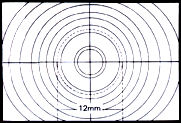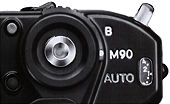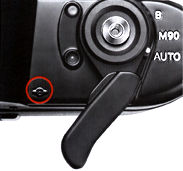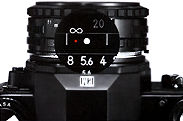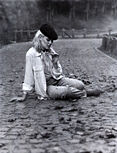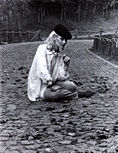|
Technical Details and Other Information |
|
|
|
| a: Explosure Measurement | |
| The Nikon EM's built-in exposure meter uses Nikon's through-the-lens(TTL)center-weighted exposure metering system. The meter "reads" the light over the entire focusing screen, but favors the central 12mm-diameter area outlined on the screen. This is where the main subject is likely to be positioned, and allows the photographer to make precise exposure readings of the selected subject area, as well as provides for overall balanced exposures. | |
|
|
|
| b: Shutter Operation Mode Selection | |
| The shutter operation mode selector has two mechanical override settings. M90 provides a shutter speed of 1/90 sec., it is also used for flash photography with an electronic flash unit other than the Nikon SB-E or SB-10 (p. 28). B is for long exposures—the shutter curtains remain open for as long as the shutter release button is kept depressed. A tripod is essential for B exposures. | |
|
|
|
| c: Film Plane Indicator | |
| This is mainly used in close-up photography to determine the exact subject-to-film plane distance. It is visible when the film winding lever is pulled out, and positioned precisely on the film plane— 46.5mm from the front surface of the lens mounting flange. | |
|
|
|
| d: Infrared Photography | |
| Both Nikon Series E and Nikkor lenses have an infrared photography focusing index for shooting with black-and-white infrared film. The image is first focused through the viewfinder, then the lens focusing ring is turned until the distance in front of the white focusing index is realigned with the red infrared index. | |
| e: Depth of Field | ||
| When you focus on your subject, you will find that objects both in front of and behind it also appear to be in focus. This "zone" of focus is called depth of field. In general, to control depth of field, use the lens aperture ring selectively, remembering that the lower the number of the aperture set (i.e., the wider the lens aperture), the "shallower" the depth of field, and vice versa. You can also use the color-coded depth-of-field indicators of Nikon Series E and Nikkor lenses. The wider the gap between two identical colors (which match the color of the lens aperture number in use), the deeper the depth of field, and vice versa. Remember, when selecting an aperture based on depth of field, the shutter speed will change accordingly. Be careful that you don't use a shutter speed which is too slow for hand-held shooting or for moving subjects. | ||
|
|
|
|
|
Lens set at f/1.8 |
Lens set at f/8 |
Lens set at f/16 |
|
Message Board |
Questions, issues & Answer(s)
| nomenclature | basic operation | how to hold the camera |
| setting up | preparing | technical details | special accessories |
| other accessories and lenses | camera care | specification |
| Message
Board |
for your Nikkor Optics in a shared environment
| Message
Board |
Specifically for Dispose or Looking for Nikon/Nikkor
Photographic Equipment
|
| Nikon EM, 1979 | |
| Nikon FG, 1982 | |
| Nikon FG-20, 1984 | |
Specifications : Nikon EM, Nikon FG, Nikon FG-20
Additional info available on : MD-14 | MD-E | SB-15 | SB-E | MF-15 Databack
Nikon Series E lenses
Developed by: EEwynFoo
Copyright 1998 © leofoo® MIR Web Development Team;
A contributing effort to Michael Liu's Classic Nikon SLR camera site.
Credit: Miss Rissa Chan, Sales manager of of Nikon Product division, Shriro Malaysia in providing the manual and making this site possible. Also dedicated to one of my friend, who recently only spent US50-00 for an EM body, smart ass... Made with a PowerMac, serves with a Linux. "Nikon", "Nikkor" and "Nikon EM" are trademarks of Nikon Corporation, Japan.
|
Home - Photography in Malaysia |
